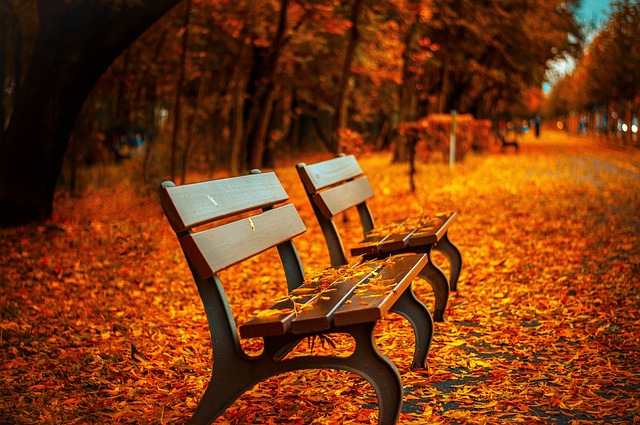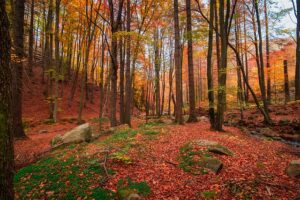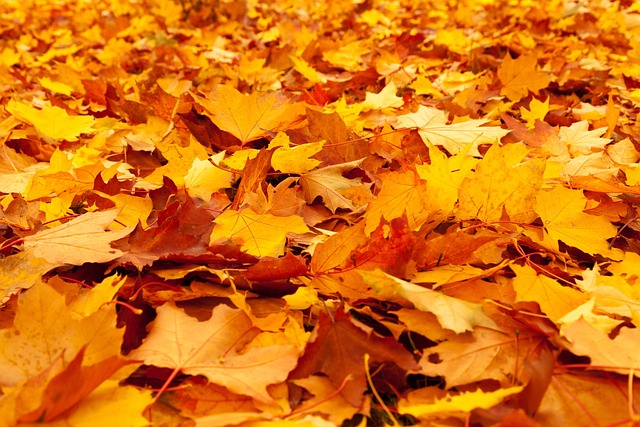Autumn 2025: Blessed Golden Tranquillity
Autumn, also known as fall in American English, is one of the four temperate seasons. It marks the transition from summer to winter and is characterised by cooler temperatures and shorter days. In the Northern Hemisphere, autumn typically occurs from September to December, while in the Southern Hemisphere, it spans from March to June.

During autumn, the leaves of deciduous trees change colour and eventually fall off, creating beautiful landscapes of red, orange, and yellow hues. This season is also associated with harvest time, as many crops are gathered during this period2. Animals prepare for the upcoming winter by gathering food and growing thicker fur2.
The wisdom behind the creation of autumn can be seen through various lenses, including natural cycles, ecological balance, and human experience:
Wisdom Behind:
- Autumn whispers of harvest and reflection. Leaves turn gold, hinting at impermanence.
- The Creator’s wisdom lies in the changing seasons, teaching us to let go gracefully.

- Natural Cycles: Autumn plays a crucial role in the Earth’s natural cycles. It marks the transition from the warmth of summer to the cold of winter, allowing ecosystems to prepare for the changing conditions. Trees shed their leaves to conserve energy and water, which is essential for their survival during the winter months.
- Ecological Balance: Autumn is a time of harvest, providing food for humans and animals alike. Many crops reach maturity in this season, ensuring that there is enough food to sustain life through the winter. Animals gather and store food, and some even migrate to warmer climates, maintaining the balance of ecosystems.
- Human Experience: Autumn has a profound impact on human culture and traditions. It is often associated with festivals, celebrations, and a sense of reflection. The changing colours of the leaves and the cooler temperatures create a unique atmosphere that encourages people to appreciate the beauty of nature and prepare for the coming winter.
- Spiritual and Philosophical Perspectives: Many people see autumn as a time of transformation and renewal. The shedding of leaves can symbolize letting go of the old to make way for new growth. It can be a reminder of the cyclical nature of life and the importance of embracing change.
These aspects highlight the intricate design and purpose behind autumn, reflecting balance and harmony in the natural world. What do you find most fascinating about autumn?
Autumn
Autumn is a season of breathtaking beauty around the world, with each region offering its unique charm. Here are some of the most enchanting autumn destinations:
destinations:
- New England, USA: Known for its stunning fall foliage, New England’s landscapes transform into a vibrant tapestry of red, orange, and yellow. Popular spots include Vermont’s Green Mountains and New Hampshire’s White Mountains1.
- Kyoto, Japan: The ancient temples and gardens of Kyoto are surrounded by colorful maple and ginkgo trees, creating a serene and picturesque setting2.
 Canadian Rockies, Canada: The majestic mountains and crystal-clear lakes of the Canadian Rockies are even more spectacular with autumn colours. Banff and Jasper National Parks are must-visit destinations1.
Canadian Rockies, Canada: The majestic mountains and crystal-clear lakes of the Canadian Rockies are even more spectacular with autumn colours. Banff and Jasper National Parks are must-visit destinations1.- Scottish Highlands, UK: The rugged landscapes of the Scottish Highlands are adorned with golden hues, making it a perfect time for hiking and exploring the scenic beauty2.
- Jiuzhaigou Valley, China: This UNESCO World Heritage site is famous for its multi-coloured lakes and waterfalls, which are even more mesmerizing in the autumn when the surrounding forests turn vibrant shades of red and yellow2.
- Plitvice Lakes National Park, Croatia: The cascading lakes and waterfalls of Plitvice are surrounded by lush forests that burst into a riot of colours during the fall season2.
- Lapland, Finland: Known for its pristine wilderness, Lapland offers a unique autumn experience with its colourful forests and the chance to witness the Northern Lights2.
- Aspen, Colorado, USA: Named after the aspen trees that turn a brilliant gold in the fall, Aspen is a popular destination for leaf-peeping and outdoor activities1.
These destinations showcase the diverse and captivating beauty of autumn across the globe. Do any of these places catch your eye?
Autumn starts at different times depending on the hemisphere:
- Northern Hemisphere: Autumn typically begins around September 22nd or 23rd with the autumnal equinox and lasts until around December 21st. This includes countries like the United States, Canada, most of Europe, and parts of Asia.
- Southern Hemisphere: Autumn starts around March 20th or 21st and continues until around June 21st. This includes countries like Australia, New Zealand, and parts of South America and southern Africa.
Yes, autumn is indeed a sign of the approaching winter season. During autumn, temperatures gradually cool down, and days become shorter as the Earth tilts away from the sun. This transition period allows both nature and humans to prepare for the colder months ahead.
Do you have any favourite autumn traditions or activities?
Autumn is a season rich with various utilities and traditions around the world. Here are some notable ones:
- Harvest Festivals: Many cultures celebrate the harvest season in autumn. For example, Thanksgiving in the United States and Canada is a time to give thanks for the harvest and blessings of the past year1. Similarly, Chuseok in Korea is a major harvest festival where families
 gather to share food and honor their ancestors2.
gather to share food and honor their ancestors2. - Cultural Celebrations: Autumn is marked by numerous cultural festivals Oktoberfest1. In China, the Mid-Autumn Festival is celebrated with moon cakes and family reunions2.
- Spiritual and Religious Observances: Many spiritual and religious traditions are linked to autumn. For instance, Samhain in Ireland and Scotland marks the end of the harvest season and the beginning of winter, and is considered the origin of modern Halloween2Mehregan in Iran is an ancient Persian festival celebrating light, kindness, and love1.
- Natural Beauty and Tourism: Autumn’s changing foliage attracts tourists worldwide. Places like New England in the USA, Kyoto in Japan, and the Canadian Rockies are renowned for their stunning fall colors2.
- Agricultural Practices: Autumn is a crucial time for farmers to harvest crops and prepare for the winter. This season ensures that there is enough food stored to last through the colder months2.
- Outdoor Activities: The cooler weather makes autumn ideal for outdoor activities such as hiking, apple picking, and visiting pumpkin patches. These activities are popular in many countries and contribute to local economies2.
- Educational and Community Events: Schools and communities often organize events like fall fairs, sports competitions, and cultural exhibitions during autumn. These events foster community spirit and provide educational opportunities2.
Autumn’s diverse utilities and traditions highlight its importance and charm across different cultures. Do you have any favourite autumn activities or traditions? 1
Maple leaves change colour during autumn due to a combination of biochemical processes and environmental factors:
- Chlorophyll Breakdown: During the growing season, chlorophyll, the pigment responsible for the green colour in leaves, is constantly produced and broken down. Chlorophyll is essential for photosynthesis, which allows plants to convert sunlight into energy. As autumn approaches, the days become shorter and temperatures drop, signalling the trees to prepare for winter. Chlorophyll production slows down and eventually stops, causing the green colour to fade12.
- Revealing Hidden Pigments: As the green chlorophyll fades, other pigments that were present in the leaves all along become visible. Carotenoids, which produce yellow and orange hues, are unmasked. These pigments are responsible for the vibrant yellows and oranges seen in maple
 leaves2.
leaves2. - Anthocyanin Production: In some trees, like maples, glucose gets trapped in the leaves after photosynthesis stops. The combination of sunlight and cool autumn nights triggers the production of anthocyanins, which are pigments that give leaves their red and purple colours. Anthocyanins protect the leaves from damage and help the tree recover nutrients before the leaves fall34.
- Environmental Triggers: The lengthening nights and cooler temperatures of autumn are the primary environmental triggers for these changes. These conditions signal the trees to begin the process of shutting down for the winter, leading to the beautiful display of fall colors2.
These processes ensure that maple trees and other deciduous trees can conserve energy and nutrients, preparing them for the dormant winter period. The result is the stunning array of colours that many people look forward to each autumn.
Do you enjoy watching the leaves change colour in the fall?
Moon cakes
Significance of Moon cakes
- Symbol of Reunion: Moon cakes symbolize family reunion and unity. They are often shared among family members and friends during the Mid-Autumn Festival, which is a time for gathering and celebrating togetherness1.
- Cultural Tradition: The round shape of moon cakes represents completeness and unity, mirroring the full moon during the festival. They are often imprinted with Chinese characters for “longevity” or “harmony,” and sometimes decorated with images of the moon, flowers, or the Moon Goddess, Chang’e2.
- Harvest Celebration: The Mid-Autumn Festival is also known as the Harvest Moon Festival. Moon cakes are a traditional food that celebrates the harvest and the abundance of the season2.
- Legend and Myth: According to Chinese legend, moon cakes played a role in the overthrow of the Mongol rulers during the Yuan Dynasty. Messages were hidden inside mooncakes to coordinate a rebellion1.
Where Moon Cakes are Celebrated
Moon cakes are primarily associated with the Mid-Autumn Festival, which is celebrated in several countries:
- China: The festival is a major holiday in China, where moon cakes are widely enjoyed and exchanged as gifts1.
- Vietnam: Known as Tết Trung Thu, the festival is celebrated with moon cakes and various activities, especially for children2.
- Taiwan: The Mid-Autumn Festival is an official holiday, and moon cakes are a central part of the celebrations2.
- South Korea: Celebrated as Chuseok, this harvest festival includes the sharing of traditional foods, including mooncakes2.
- Japan: Known as Tsukimi or “moon-viewing,” the festival includes eating moon cakes and other traditional foods while admiring the full moon2.
- Singapore and Malaysia: The festival is celebrated with moon cakes and lantern parades, reflecting the multicultural heritage of these countries2.
Mooncakes have also gained popularity in other parts of the world, especially in regions with significant Chinese communities. They are often enjoyed with tea and come in various flavours and styles, reflecting local tastes and traditions.
Have you ever tried moon cakes or participated in a Mid-Autumn Festival celebration?
Mood Fluctuations Phenomenon
The change in seasons, particularly the transition into autumn, can be associated with mood fluctuations, including feelings of sadness or loneliness. This phenomenon is often linked to Seasonal Affective Disorder (SAD), a type of depression that occurs at specific times of the year, usually in the fall and winter months12.
Scientific Reasons for Mood Fluctuations in Autumn

- Reduced Daylight: As autumn progresses, the days become shorter and there is less natural sunlight. This reduction in daylight can disrupt the body’s internal clock, or circadian rhythm, which regulates sleep-wake cycles and other physiological processes2.
- Melatonin and Serotonin Levels: The decrease in sunlight can lead to an increase in the production of melatonin, a hormone that regulates sleep. Higher melatonin levels can make people feel more lethargic and sleepy. At the same time, reduced sunlight can lower serotonin levels, a neurotransmitter that affects mood, leading to feelings of depression2.
- Vitamin D Deficiency: Less exposure to sunlight can result in lower levels of vitamin D, which is important for maintaining mood and overall health. Vitamin D deficiency has been linked to depression and other mood disorders2.
- Psychological Factors: The transition to autumn can also bring about psychological changes. The end of summer and the approach of winter can lead to feelings of loss or anticipation of the colder, darker months ahead. This can contribute to mood fluctuations and feelings of sadness or loneliness2.
Coping Strategies
If you or someone you know experiences mood fluctuations during autumn, here are some strategies that might help:
- Light Therapy: Using a light box that mimics natural sunlight can help regulate melatonin and serotonin levels.
- Regular Exercise: Physical activity can boost mood and energy levels.
- Healthy Diet: Eating a balanced diet rich in fruits, vegetables, and whole grains can support overall well-being.
- Social Interaction: Staying connected with friends and family can provide emotional support.
- Professional Help: If feelings of sadness or depression persist, it may be helpful to seek advice from a healthcare provider or mental health professional.
Understanding the scientific reasons behind these mood changes can help in finding effective ways to manage them. Have you noticed any changes in your mood with the changing seasons?
1: Explore the World’s Best Destinations for Viewing Nature’s Autumnal Beauty 2: Autumn Around the World: 14 Pretty Places to Leaf Peep
10 Incredible Autumn Traditions from Around the World 2: 16 Fascinating Autumn Traditions & Harvest Festivals Around the World
1: Science of Fall Colors | US Forest Service 2: Why do tree leaves change in the fall? – Maple Leaves Forever 3: Fall Foliage: When, Why & How Vibrant Will Maple Leaves Be? 4: Autumn Leaves and Fall Colors – Why do autumn leave change color?
1: Moon cake – Wikipedia 2: What are moon cakes? Behind the Mid-Autumn Festival treat – TODAY
1: Seasonal sensitivity and psychiatric morbidity: study about seasonal affective disorder 2: Mental health and the holidays: Seasonal depression
If you enjoyed this article, please like and share it with your friends. Don’t forget to Share your personal experience/observations thoughts and valuable suggestions for the education /benefit of others. Do subscribe to remain onboard and get more great content!
Winter 24/25: The Epic Wisdom Behind Different Weathers All Year Long


